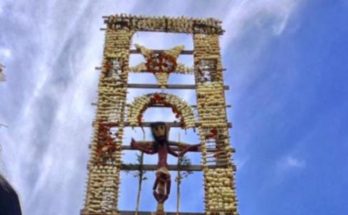By Arturo Morales Tirado
Between the decades of 1530 and 1540, the first Europeans arrived in the area of the Inland Border between the zone of semi-desert, in arid America, and the volcanic Mesoamerica. This process of cultural exchange was the seed that eventually led to our syncretic society. The locals in the area were the Chichimecas, composed of different ethnic groups—Caxcanes, Guamares, Huaxabanas—were confronted with the Spaniard forces and some Otomi allies from Jilotepec, plus some indigenous people from Tlaxcala and Oaxaca. What motivated the Spaniards and their indigenous allies was finding precious metals and minerals. These geological frontier lands were filled with metamorphic rocks associated with precious heavy metals such as mercury, silver and gold. Along this, there was still another motivation, and it was to expand Catholicism. This was the dominant ideology of the nascent and powerful Catholic Kingdom of Spain, which, since 1492, had been consolidating itself as the great political-military power in Europe.
When Antonio de Mendoza, the first viceroy of New Spain, arrived these two motivations fused. In 1531, this brought about the foundations of two cities: San Juan del Río and Santiago de Querétaro. The Spaniards and their indigenous allies were led by Hernando de Tapia Conín and Nicolás de San Luis Montañés. Beginning with those years began a process of fusion of two great cultures. There was the existing pre-Hispanic Mesoamerican civilization with more than 2000 years of evolution already present in the region. But the incoming one was the Spanish-European culture and traditions, which in turn, had a very long history. It dated back to Greco-Latin cultural ancestry, with roots of the language, for example. There was also the Jewish and Arab influence, a product of more than 800 years of coexistence in the Iberic peninsula. There was the history of Moorish domination and feuds with Catholics, and the eventual re-conquest of Spain by the Catholic Monarchs in 1492. Some of the first evangelizing groups to arrive in New Spain were Catholic missionary friars, with a mysticism typical of their time. They were willing to risk their lives in their quest to establish Catholic faith in the territories of military conquest.
There is a legend of a mythical battle on the Sangremal hill in Santiago de Querétaro. According to the story, in the midst of the battle between Chichimecas against Otomíes and Spaniards, the Santa Cruz (Holy Cross) appeared. This cross is present to date, made of cantera and with an octagonal profile. It is found, along with the foundation of one of the largest convents in the region—Convento de la Santa Cruz. This is one of the first examples of syncretism between the American Indian and European Spanish.
In our region, after a decade of unsuccessful attempts, the town of San Miguel was founded in 1542. It was built around a chapel made of sticks and adobe, which would be destroyed by the Chicichimecas three years later. All of this took place during the nascent Chichimeca Wars. Some years later, in 1546, came the discovery of the silver and gold ore deposits in Zacatecas and Guanajuato. Two royal mines would be founded in 1546 and 1555, respectively. They were faced with the pressing need to have a safe intermediate town between Guanajuato and Querétaro, along the incipient Ruta de la Plata del Camino Real de Tierra Adentro (Silver Route of the Royal Inland Road). It was then that the foundation of our present San Miguel was established. It began as Villa Protectora de San Miguel (Protected Village of San Miguel) decreed as a protected space by the Spanish crown. Around this foundation, different villages of peaceful Indians settled and built small chapels to house administrative centers. These centers became the emblems of the merging of two cultural traditions: the Catholic-European and the pre-Hispanic-Mesoamerican. For many years they were known as Indian chapels, a viceregal denomination.
Around these Indian chapels, settlements of various people continued. There were Creoles and Spaniards, people from the haciendas, from prisons; as well communities and gangs of peaceful Indians. During the centuries-long process, the indigenous leaders generally tried to preserve their customs and rituals. These rituals usually revolved around natural cycles, mostly linked to agricultural cycles and these festivals eventually merged and became part of the Catholic ritual calendar. The rituals and festivals revolved around the equinoxes, solstices and the two zenithal days of the sun. Many ritual dates of great importance were established in spring and summer: the Lord of the Conquest (associated with planting), the Holy Cross (cultivation), Saint John the Baptist (rains), Saint Michael the Archangel (harvest). Others were during the time of autumn and winter: Virgen de Guadalupe (recurring frosts). Some celebrations fall between equinoxes and solstices: San Isidro Labrador, Assumption of the Virgin Mary, Day of the Dead, Virgin of Candelaria. These ritual dates were celebrated around the Indian chapels. Small variants of these can be found in the various regions of Mesoamerica, and our Inland Border is no exception.




